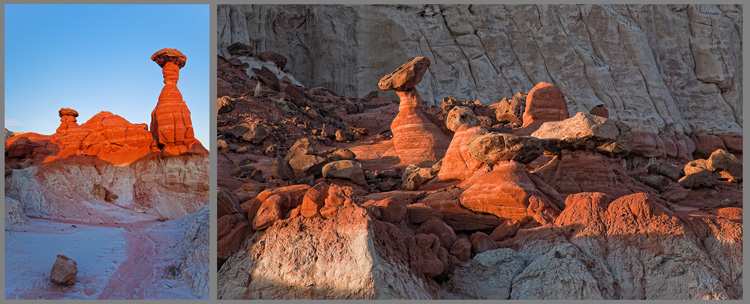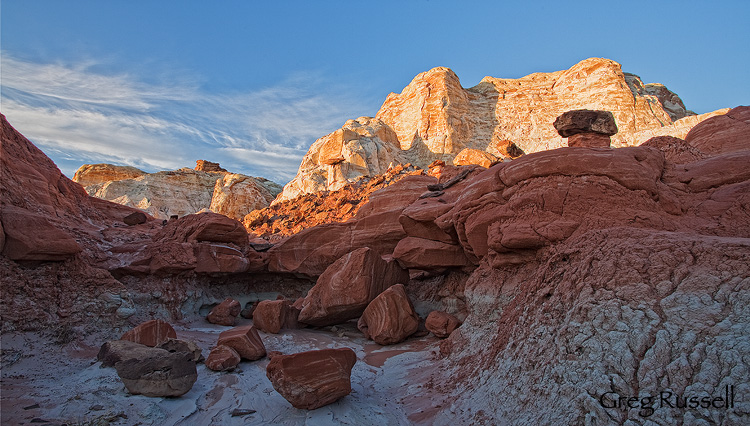All rocks are not created equally; not only do they vary in surface characteristics like color and shape, they also vary in properties that aren’t immediately visible. Rocks erode at different rates, and the elements that make them up oxidize differently, giving rock formations different colors as time passes. These characteristics are what gives the Colorado Plateau its uniqueness–there really is no other biome on earth quite like it.
Any visitor to the southwest should become quickly acquainted with hoodoos–rock spires usually found protruding from a drainage or badlands. Hoodoos are typically formed when a rock or boulder from a newer (therefore stratagraphically higher) layer of sandstone falls onto an older layer. The boulder erodes more slowly, but it also protects the rock underneath it from eroding, leaving the characteristic spire with the cap rock on top of it–in this way the cap rock almost shelters the underlying rock from erosion.
On my recent trip to Utah, I made a couple of sunset visits to the Toadstool Hoodoos, located in the extreme southern end of the Grand Staircase-Escalante National Monument. Like other hoodoos, the Toadstools were formed when boulders from the Dakota Formation fell onto the older rock of the Entrada Formation. Dakota Sandstone erodes more slowly, leaving vibrantly colored hoodoos in a stunning badlands setting.
(Click on the diptych to view it large.)
A large part of the draw of the Colorado Plateau is the interesting geology. For me, its one thing to marvel over a beautiful formation; its another, more fulfilling, thing to marvel over how it formed.



I’m also just as fascinated with the process as with the results of the “other worldly” formations of this area. It is just mind boggling. I don’t think I will ever tire of exploring this area.
Hoodoo Garden is a very nice image. It shows the process in an artistic way. You feel like if you waited there for another few hundred years you might see another chunk of sandstone fall away.
Best Regards,
Greg…..
Very nice photographic essay, Greg. This is so different from the environment I have here in New England…like another world. I really enjoy seeing the places you visit and your thoughts that accompany the images. Nice geologic theory to accompany all as well. Cool stuff!
Interesting. I never knew how they formed. Good post Greg. Good photos too.
Great images, thanks for sharing!!
We’ve got them here in Texas, too – those hoodoos are always fun to work with!!
Really interesting Greg… I didn’t know half of that… Juanli and I have got to get back to the States at some stage.. great diversity.. your images continue to inspire..
Thanks so much for the comments, guys! I really appreciate your thoughts and your stopping by.
The alternate title for this blog post was, “Hoodoo? You do.”
Beautiful, Greg. I like the cap rocks. What incredible structures there are in the west!
Sharon
Interesting post with the geology. It reminds me of how my father used to talk at length about the geology of the Colorado Plateau. I also like your photographs, particularly the top left one with the blues and other shades.
very nice colors!!! woow